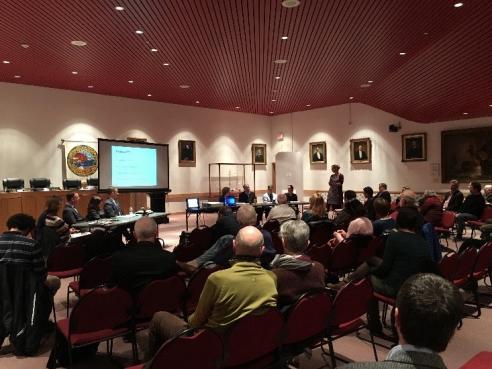McIntyre Panels Examine Transportation, Parking, and Partnership
March 9, 2018
The City of Portsmouth continued the second stage of the McIntyre public input process on Tuesday, March 6th, with two panel discussions focused on transportation and parking, and the elements of a public-private partnership.
The McIntyre Blue Ribbon Steering Committee is hosting these in-depth discussions, which dive into topics that citizens have highlighted as important to the future of the Thomas J. McIntyre Federal Building and property.
“Our second evening of panel discussions once again showcased the interest and energy from Portsmouth residents when it comes to the future of the McIntyre building,” said City Councilor Chris Dwyer. “This was an engaging discussion that featured interesting questions, opinions and commentary by audience members and our panel of experts. This project is a tremendous opportunity for the City, and the public input process will ensure we put forth the very best submission for the McIntyre building.”
During the first discussion, panelists and audience members discussed ways to minimize vehicle traffic, reduce the demand for parking, and ensure that the final McIntyre design is pedestrian and bike friendly. Panelists highlighted a variety of tools that can help enhance walkability, including creating wide sidewalks, ample open space, connectivity between buildings, enhanced lighting and a first floor space that is inviting and draws people in. Panelists also addressed potential future concerns related to transportation and parking, and stressed the importance of making the project accessible to all.
“The development teams continues to be inspired by the insight and input we’re receiving from the community, and we know that this collaborative process will result in a more compelling and creative design,” said Michael Kane from the Redgate/Kane development team. “The topics that we’re delving into throughout this process – transportation, parking, public-private partnerships, urban design, and historic preservation – are integral to the future of this site and project. And it’s been very gratifying to have the opportunity to hear from the community on each of these crucial elements.”
The second panel centered on the elements necessary to create an effective public-private partnership between the City of Portsmouth and the developer – particularly the need for a high level of collaboration. Panelists discussed the importance of project feasibility and balancing public amenities and private space. Increasing project density was highlighted as one way to ensure the final McIntyre design remains feasible and features the high level of public amenities desired for the site.
Audience members and panelists also discussed some of the environmental and historic challenges that must be managed, and the advantage created by the fact that businesses are increasingly looking for space they can grow into downtown. They asked that the developer leverage the features that make Portsmouth such a desirable community in the final McIntyre design – including its historic character and vibrant waterfront.
“The public space we ultimately create is critical to the success of this project because that is what is going to attract residents, businesses and visitors,” said Steve Perdue of the development team, who participated in the second panel. “The input we’re receiving will influence the final McIntyre design and ensure we are creating a space that is flexible and high quality, and something Portsmouth can be proud of for generations to come.”
A third public input session will take place on Saturday, March 10th and will feature breakout sessions so that citizens can provide more input on the various issues raised and themes that have emerged during the first two sessions. This discussion will take place in City Council Chambers from 9 a.m. to noon.
